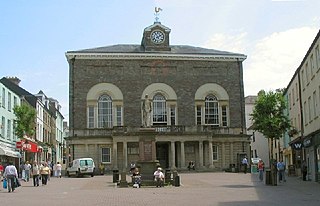
Surrey is a ceremonial county in South East England and one of the home counties. It is bordered by Greater London to the northeast, Kent to the east, East and West Sussex to the south, and Hampshire and Berkshire to the west. The largest settlement is Woking.

The London Borough of Richmond upon Thames in southwest London, England, forms part of Outer London and is the only London borough on both sides of the River Thames. It was created in 1965 when three smaller council areas amalgamated under the London Government Act 1963. It is governed by Richmond upon Thames London Borough Council and is divided into nineteen wards. The population is 198,019 and the major settlements are Barnes, East Sheen, Mortlake, Kew, Richmond, Twickenham, Teddington and Hampton.

Sir William Chambers was a Swedish-Scottish architect, based in London. Among his best-known works are Somerset House, and the pagoda at Kew. Chambers was a founder member of the Royal Academy.
Richmond is a town in south-west London, 8.2 miles (13.2 km) west-southwest of Charing Cross. It stands on the River Thames, and features many parks and open spaces, including Richmond Park, and many protected conservation areas, which include much of Richmond Hill. A specific Act of Parliament protects the scenic view of the River Thames from Richmond.

Edmund Kean was a celebrated British Shakespearean stage actor, who performed, among other places, in London, Belfast, New York, Quebec, and Paris. He was known for his short stature, tumultuous personal life, and controversial divorce.

Sir Robert Taylor (1714–1788) was an English architect and sculptor who worked in London and the south of England.
Catherine Maria Fanshawe (1765–1834) was an English poet whose work was praised by Walter Scott. She and her sisters were also artists.

Barn Elms is an open space in Barnes in the London Borough of Richmond upon Thames, located on the northerly loop of the River Thames between Barnes and Fulham.

The Municipal Borough of Richmond or Richmond Municipal Borough was a municipal borough in Surrey, England from 1890 to 1965.

Eille Norwood was an English stage actor, director, and playwright best known today for playing Sherlock Holmes in a series of silent films.

Sir John Whittaker Ellis, 1st Baronet was Lord Mayor of London for 1881–82, in which year he was made a baronet. Two years later he was elected and re-elected Conservative Member of Parliament for eight years, not seeking further re-election. A very prosperous banking executive, estate agent and auctioneer among his legacies was a fire station at Byfleet, Surrey; he sat on the boards of various hospitals and his wife was also engaged in charities.
Richmond County School for Girls was a school at Richmond in London that was once noted for having cricket in its curriculum; which resulted in the emergence from the school of a number of female cricketers, some of whom went on to play for England.

George Lambert was an English landscape artist and theatre scene painter. With Richard Wilson he is recognised as a pioneer of British landscape in art, for its own sake.

Robert Allen Rolfe was an English botanist specialising in the study of orchids. For a time he worked in the gardens at Welbeck Abbey. He entered Kew in 1879 and became second assistant.
James Love (1721–1774) was the pseudonym of British poet, playwright and actor James Dance. He is best known for his poem Cricket: An Heroic Poem (1744).

Peper Harow is a rural village and civil parish in southwest Surrey close to the town of Godalming. It was a noted early cricket venue. Its easternmost fields are in part given up to the A3 trunk road.

The Museum of Richmond in the London Borough of Richmond upon Thames is located in Richmond's Old Town Hall, close to Richmond Bridge. It was formally opened by Queen Elizabeth II on 28 October 1988.
William Roxby Beverly or Beverley (c.1810–1889) was an English theatrical scene painter, known also as an artist in oils and watercolour. William John Lawrence, writing in the Dictionary of National Biography, considered him second only to Clarkson Stanfield among British scene painters of the 19th century.

Richmond Green cricket ground, on The Green at Richmond, London, has been a venue for cricket matches since the 17th century. The earliest reference dates from May 1666 and some top-class matches were played there in the first half of the 18th century. A match in 1731, which culminated in a riot, is the earliest in cricket history of which team scores are known. The result of a match in July 1741 is the sport's earliest known tie.
Richmond Theatre may refer to:

















